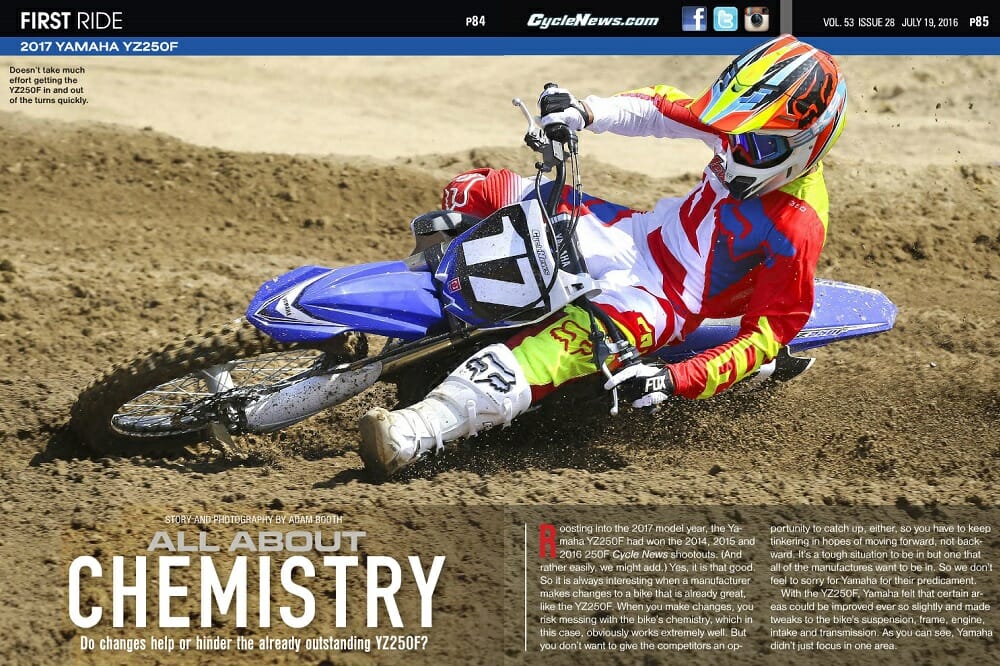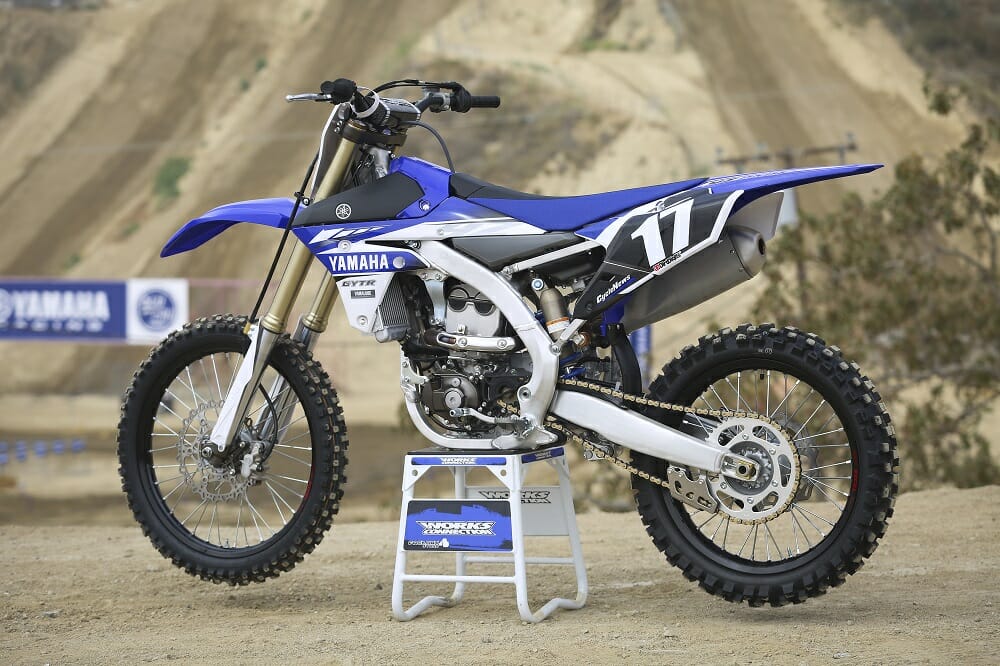| July 22, 2016
Do changes help or hinder the already outstanding YZ250F? Roosting into the 2017 model year, the Yamaha YZ250F had won the 2014, 2015 and 2016 250F Cycle News shootouts. (And rather easily, we might add.) Yes, it is that good. So it is always interesting when a manufacturer makes changes to a bike that is already great, like the YZ250F.

When you make changes, you risk messing with the bike’s chemistry, which in this case, obviously works extremely well. But you don’t want to give the competitors an opportunity to catch up, either, so you have to keep tinkering in hopes of moving forward, not backward. It’s a tough situation to be in but one that all of the manufactures want to be in. So we don’t feel to sorry for Yamaha for their predicament.
With the YZ250F, Yamaha felt that certain areas could be improved ever so slightly and made tweaks to the bike’s suspension, frame, engine, intake and transmission. As you can see, Yamaha didn’t just focus in one area.

To read this in Cycle News Digital Edition Magazine, click HERE.
Story and Photography By Adam Booth
Engine Tweaks And Improvements
Wanting to improve overall power to the already fast YZ250F rearward slanted engine, Yamaha gave it a new cylinder head with an even straighter intake port and new shape, increasing the flow rate. Larger valve seats also increase flow. In conjunction with the new cylinder, the air boot was shortened and a new throttle body joint now features an aluminum core for improved fuel vaporization. New intake and exhaust cams have more lift and stronger valve springs.
The mid-pipe diameter is larger and the bend radius has been increased, further boosting mid-to-top power. These changes are all aimed at increasing the power from 7000 to 14,000 rpm without compromising bottom-end grunt.
With increased power for 2017, Yamaha added a heat treatment to the engine cases and the connecting rod has a new shape with a material change for improved durability. Revisions to the ECU make the rev-limiter sequence quicker and more abruptly, letting the YZ250F engine pull all the way to the 14,000 rpm limiter. Last year’s power was decreased as it approached the 14,000 rpm rev-limiter on a longer-cut sequence.
 It doesn’t look much different, but Yamaha went through the 2017 YZ250F with a fine-tooth comb.
It doesn’t look much different, but Yamaha went through the 2017 YZ250F with a fine-tooth comb.
Inside the cases, third and fifth gears are beefed up and oil supply holes and grooves have been added to the transmission shafts. To improve shifts, the shift drum has been updated and the shifter lever is a new material for a 76% increase in strength. Yamaha claims the stiffer shifter makes the distance between gears feel shorter. The position of the shift lever is also changed to match the now 5mm lower footpegs. To make clutch lever pull even smoother, a bushing was added to the clutch arm assembly while the clutch cable bracket position now has a more direct pull.
 Light and agile, the YZ250F gives you confidence in the air.
Light and agile, the YZ250F gives you confidence in the air.
Massaging The Chassis
For 2017 Yamaha focused chassis changes on increasing rigidity, so the YZ250F frame received a 12mm increase in width at the swingarm pivot. The upper and lower engine mounts have a new shape while the lower engine mounts have been switched from aluminum to steel. The outer fork-tube thickness was increased, improving rigidity and allowing Yamaha to decrease the fork-spring rate from 4.7 Nm to 4.6 Nm. The shock maintains the same spring rate but new damping settings work in conjunction with the chassis changes.
 Yamaha found more high-revving power out of the YZ250F without sacrificing all-important torque and bottom-end.
Yamaha found more high-revving power out of the YZ250F without sacrificing all-important torque and bottom-end.
Long Live The King?
Our fears that Yamaha might’ve messed with an already good thing evaporated within a few laps as the familiar low-end torque pulled hard out of the corners and the compliant suspension kept us carving up the corners and navigating the straightaways with confidence.
Kudos to Yamaha for indeed increasing the power through the mid and top without taking anything away from the off-idle power the YZ250F is famous for. Each gear can be held a little longer before shifting. We also found we didn’t need to use the clutch as much, just let the torquey engine do the work. The new rev limiter sequence works nicely, giving the sensation that the 2017 YZ revs farther than the 2016, even though they both top out at 14,000 rpm. The YZ250F has a broad, easy-to-use powerband that suits beginners all the way to pros.
 Sharp bends have been taken out of the exhaust pipe routing to improve flow.
Sharp bends have been taken out of the exhaust pipe routing to improve flow.
With the chassis and engine mount changes, the softer fork spring rate doesn’t result in a soft-feeling front end. Through testing, Yamaha found the stiffer fork tubes created less stiction, allowing them to go softer and maintain the same feel, which means the KYB SSS fork feels much like it did in 2016. Plain and simple, the KYB spring fork is awesome. A benefit of the spring fork is it works well for a wide range of rider size and speed, keeping our light pro riders smiling and handling heavier vet-speed riders nicely. It also doesn’t need nearly as much tinkering and clicker adjustment as an air fork, which constantly needs checking and fine-tuning. Overall the balance and suspension action is excellent on the 2017 YZ250F. It is plush on the little hack bumps, yet handles big hits and G-outs with ease and rarely bottoms out.
 New engine mounts have been redesigned to improve feel. It’s been discovered lately that engine mounts do a lot more than just hold the engine in place.
New engine mounts have been redesigned to improve feel. It’s been discovered lately that engine mounts do a lot more than just hold the engine in place.
Ride height, Yamaha recommends 100mm; we went down to 105mm depending on track conditions. With any bike, subtle handling changes can be made through sag, high-speed compression on the shock, fork height and fork settings—all adjustments the YZ250F responds well to. With great suspension and a good chassis, the 2017 Yamaha YZ250F corners nicely, especially in the ruts. It will carve a flat corner, but depending on the track surface the front end can feel a bit vague and sometimes push. Tire selection, sag settings and rider position play a big roll in front wheel traction. Stability is another strong suit for the YZ250F, whether it be under acceleration or on the binders through braking bumps, it stays straight and predictable.
 New Bridgestone tires provide a bigger bite.
New Bridgestone tires provide a bigger bite.
The YZ250F feels nimble (it is one of the lightest bikes in the class), it is balanced, the suspension is plush with great bottoming resistance, and overall it is easy to ride fast. We love the improved engine power and suspension.
To our delight, Yamaha did indeed pull off a major accomplishment by improving on what was already an outstanding motorcycle. We’re looking forward to shootout time to see if any of the other manufacturers have come up with anything that will knock the YZ250F off its throne. CN

SPECIFICATIONS: 2017 Yamaha YZ250F
|
|
Engine
|
Liquid-cooled DOHC 4-stroke, single-cylinder
|
|
Displacement
|
249cc
|
|
Bore x Stroke
|
77.0 x 53.6mm
|
|
Compression Ratio
|
13.5:1
|
|
Transmission
|
5-speed
|
|
Fuel System
|
Keihin 44mm throttle body
|
|
Clutch
|
Wet multi-disc
|
|
Front Suspension
|
KYB Speed-Sensitive System (SSS) inverted fork; fully adjustable
|
|
Rear Suspension
|
KYB monoshock; fully adjustable
|
|
Front Wheel Travel
|
12.2 in.
|
|
Rear Wheel Travel
|
12.4 in.
|
|
Front Brake
|
Single 270mm disc, 2-piston caliper
|
|
Rear Brake
|
Single 240mm disc, 1-piston caliper
|
|
Front/Rear Rims
|
1.60 x 21”, 2.15 x 19”
|
|
Front/Rear Tires
|
80/100-21 Bridgestone M403A; 100/90-19 Bridgestone M404
|
|
Seat Height
|
38 in.
|
|
Wheelbase
|
58.1 in.
|
|
Ground Clearance
|
12.8 in.
|
|
Curb Weight, Approx (gas tank full)
|
231 pounds
|
|
Tank Capacity
|
2.0 gallons
|
|
Colors
|
Team Yamaha Blue, White/Red
|
|
MSRP
|
$7,699
|
To read this in Cycle News Digital Edition Magazine, click HERE.
For more Cycle News Motocross motorcycle reviews, click HERE.